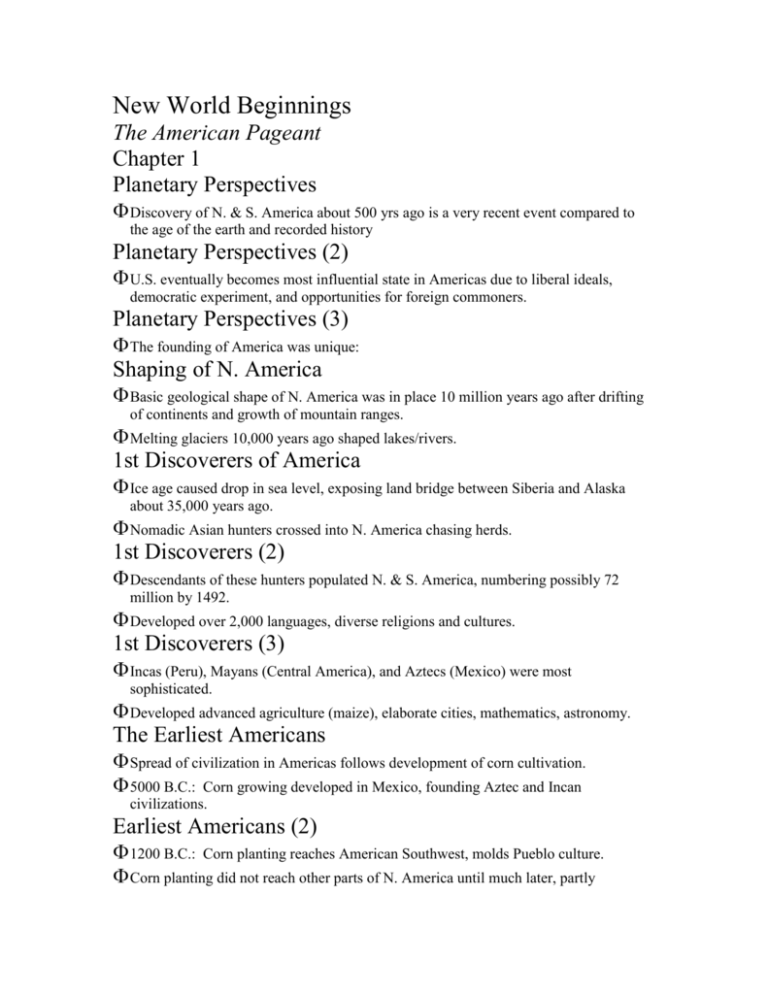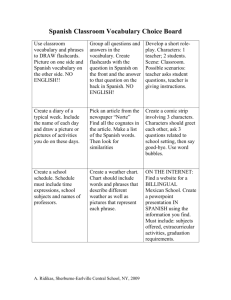New World Beginnings
advertisement

New World Beginnings The American Pageant Chapter 1 Planetary Perspectives Discovery of N. & S. America about 500 yrs ago is a very recent event compared to the age of the earth and recorded history Planetary Perspectives (2) U.S. eventually becomes most influential state in Americas due to liberal ideals, democratic experiment, and opportunities for foreign commoners. Planetary Perspectives (3) The founding of America was unique: Shaping of N. America Basic geological shape of N. America was in place 10 million years ago after drifting of continents and growth of mountain ranges. Melting glaciers 10,000 years ago shaped lakes/rivers. 1st Discoverers of America Ice age caused drop in sea level, exposing land bridge between Siberia and Alaska about 35,000 years ago. Nomadic Asian hunters crossed into N. America chasing herds. 1st Discoverers (2) Descendants of these hunters populated N. & S. America, numbering possibly 72 million by 1492. Developed over 2,000 languages, diverse religions and cultures. 1st Discoverers (3) Incas (Peru), Mayans (Central America), and Aztecs (Mexico) were most sophisticated. Developed advanced agriculture (maize), elaborate cities, mathematics, astronomy. The Earliest Americans Spread of civilization in Americas follows development of corn cultivation. 5000 B.C.: Corn growing developed in Mexico, founding Aztec and Incan civilizations. Earliest Americans (2) 1200 B.C.: Corn planting reaches American Southwest, molds Pueblo culture. Corn planting did not reach other parts of N. America until much later, partly explaining lack of developed societies. Earliest Americans (3) Maize, beans, and squash (“three-sister” farming) developed in S.E. Atlantic coastal region about 1000 A.D, producing high population densities among Creek, Choctaw, Cherokee. Earliest Americans (4) Iroquois in N.E. woodlands developed most sophisticated society in N. America in 16th Cent. (Hiawatha) However, generally N. America was sparsely populated without permanent settlements. Earliest Americans (5) Many native cultures conferred substantial authority on women, developing matrilinear cultures. Natives made little impact on land, b/c of nature-based worldview, lack of tech., and sparse population. Indirect Discoverers Vikings from Scandinavia land in Newfoundland about 1000 A.D., settlements abandoned. Christian crusaders developed taste for Asian goods: silk, drugs, perfumes, draperies, spices (sugar). Indirect Discoverers (2) Asian products very expensive in Europe (distance, Muslim middlemen led to higher costs). Desired less expensive trade routes, alternative sources. Marco Polo’s description of Asia (1295) increased desires. Europeans Enter Africa 1450: Portuguese developed caravel, a ship that could sail more closely into wind, enabling them to sail back from coast of West Africa. Set up trading posts along coast for gold, slaves. Europeans Enter Africa (2) Origins of modern plantation system found in Portuguese slave trade/Atlantic sugar islands. 1498: da Gama sails around Africa to India, expanding trade. Columbus to New World Late 15th Cent: Unification of Spain by marriage of Ferdinand and Isabella, and expulsion of Moors (“reconquista”). Unification led to desire to outdo Portugal in tapping wealth of Indies. Columbus to New World (2) Because Portugal controlled southern routes, Spain looked west. Development of printing press, mariner’s compass, and Renaissance-based optimism also influenced expansion. Columbus to New World (3) Creation of modern nation-state in Spain produced unity, wealth, and power necessary to support discovery, conquest, colonization. Columbus to New World (4) Columbus (Italian) convinced Spanish monarchs to underwrite voyage. After 6 weeks, Columbus landed in Bahamas on Oct. 12, 1492 – thought he found Indies. When Worlds Collide Exchange of animals/crops: tobacco, maize, beans, tomato, potato to Europe; sugar cane, cattle, swine, horses to New World (chart on p. 14). Smallpox, yellow fever, malaria devastated Natives. When Worlds Collide (2) By approx. 1600, 90% of Native population perished, most due to disease, having never even seen a European. Syphilis given to Europeans by Natives. Spanish Conquistadores Spain secured claim to New World in Treaty of Tordesillas with Portugal (1494), and became dominant colonizing power in 1500s. Spanish Conquistadores (2) Conq’s motivated by obsession with status and honor, religious zealotry and intolerance. Lengthy reconquista created a soldier class who were no longer interested in labor/ commerce. Spanish Conquistadores (3) Notable achievements: Spanish Conquistadores (4) Notable achievements (cont’d): Spanish Conquistadores (5) Flood of precious metal from New World resulted in inflation in Europe – fueled capitalism, commercial banking system. “Encomienda”: Indians given to colonists to Christianize them (basically slavery). Conquest of Mexico 1519: Cortez sailed from Cuba with only 16 horses and a several hundred men. With two key interpreters and 20,000 Indian allies, he marched on Tenochtitlán (Aztec capital). Conquest of Mexico (2) Montezuma believed Cortez to be god Quetzalcoatl fulfilling prophecy, allowed Cortez into Tenochtitlán Aztecs eventually attacked – Cortez laid siege, conquering city (1521). Spread of Spanish America By mid-1500s, there were hundreds of Spanish cities and towns, especially in Peru and Mexico (silver). Universities established at Mexico City and Lima, Peru (1551). Spread of Spanish America (2) Northern borders of Spanish America threatened by English, French. Began to fortify northern boundary: St. Augustine, FL – oldest continually inhabited European settlement (1565). Spread of Spanish America (3) Expedition to New Mexico found little gold, but found many Pueblo people to convert to Catholicism (1609) Roman Catholic mission became central institution in New Mexico. Spread of Spanish America (4) Missionary efforts to suppress native customs led to Pope’s Rebellion by Pueblos (1680). Destroyed every Catholic church and killed hundreds. Took almost 50 yrs for Spanish to reclaim New Mexico. Spread of Spanish America (5) 1716: Weak presence in Texas, established mission later called Alamo in San Antonio. 1769: Spanish missionaries (Serra) founded mission at San Diego, later chain of 21 missions in California. Spread of Spanish America (6) “Black Legend,” – concept that Spanish “killed for Christ,” stole natives’ gold, infected them with Smallpox, etc. While partly true, Spanish also incorporated cultures, laid foundation for nations, etc.







